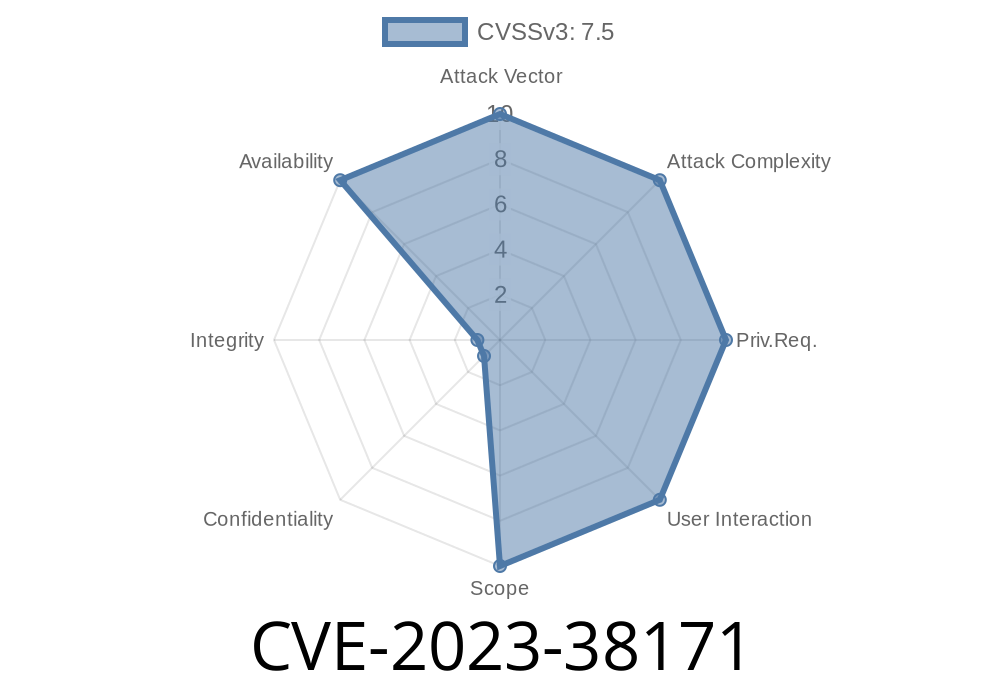The Common Vulnerabilities and Exposures (CVE) system recently assigned the identifier CVE-2023-38171 to a critical security vulnerability found in Microsoft QUIC, a prominent implementation of the QUIC protocol. This post aims to provide an in-depth analysis of this security flaw, covering how the vulnerability works, available patches to remediate the vulnerability, and ways to mitigate the risks associated with this issue.
Background: What is Microsoft QUIC?
QUIC is a transport layer protocol developed by Google to provide reliable and secure encrypted communication channels using the User Datagram Protocol (UDP) as its foundation. Among the key improvements it brings over the traditional Transmission Control Protocol (TCP) are reduced latency and better congestion control. This makes it particularly suitable for real-time applications, such as video streaming and voice calls.
Microsoft QUIC is Microsoft's implementation of this protocol, offering a high-performance and secure communications channel for its services and applications. With the widespread adoption of the QUIC protocol and Microsoft's strong presence in the market, many enterprise systems rely on Microsoft QUIC for efficient communication.
CVE-2023-38171: The Vulnerability
CVE-2023-38171 is a denial of service (DoS) vulnerability in Microsoft QUIC. An attacker exploiting this vulnerability can cause a targeted system to become unavailable for legitimate users. This vulnerability stems from the way Microsoft QUIC processes specially crafted packets. Through a remote, unauthenticated attack, a malicious actor can trigger a crash in the targeted system's QUIC implementation, causing disruption to the normal operation of the affected software or service.
A simplified code snippet illustrating the issue is as follows
void process_packet(QUIC_PACKET* packet) {
// Incorrect handling of specially crafted packets
if (is_malicious_packet(packet)) {
cause_dos();
} else {
process_as_normal(packet);
}
}
The Exploit
While we will not detail the exact steps to reproduce the exploit in this post, it involves a series of steps that an attacker initiates to generate and send a specially crafted packet, precisely timed to exploit the vulnerability. This exploit does not require special privileges or direct access to the targeted system.
Important Notice: We strongly discourage using this information for any malicious purposes. The information provided here is for educational and awareness purposes only.
Impact
The primary impact of a successful exploitation of CVE-2023-38171 is a denial of service attack, rendering the targeted software or service temporarily unavailable. Depending on the criticality of the affected system, this could bring serious disruptions to an organization's operations. Additionally, repeated successful DoS attacks could lead to a significant erosion of trust by the targeted organization's clients or users.
Patching Recommendations
Microsoft has already released a security update to address CVE-2023-38171. It is highly recommended for organizations and users currently utilizing Microsoft QUIC to apply the necessary patch as soon as possible. The update is available through the standard Windows Update mechanisms, as well as via the Microsoft Download Center here.
Mitigation Strategies
While patching should always be the primary response to a vulnerability, we understand that some organizations may need time to test and deploy the update. In such cases, organizations can use the following mitigation strategies to reduce the risk associated with CVE-2023-38171:
1. Restrict network access: Limit the exposure of systems running Microsoft QUIC to the internet. Implement strict network segmentation and perimeter controls to minimize direct exposure.
2. Monitor for abnormal QUIC traffic: Be vigilant for any sudden spikes or unusual patterns in QUIC traffic within your network. This could indicate an attempt to exploit the vulnerability.
3. Rate limiting: Configure rate limiting on systems and network equipment to prevent a single source from generating excessive QUIC traffic.
Conclusion
The CVE-2023-38171 vulnerability in Microsoft QUIC represents a potentially significant risk to organizations relying on this technology for efficient and secure communications. This post has covered the necessary background, exploit details, patching recommendations, and mitigation strategies for addressing this issue. We urge all affected parties to take immediate action in remedying the vulnerability to safeguard their systems and services against potential attacks.
For further reading and original references related to CVE-2023-38171, please consult the following resources:
- Microsoft Security Advisory
- NIST National Vulnerability Database (NVD)
- Common Vulnerabilities and Exposures (CVE) Entry
Timeline
Published on: 10/10/2023 18:15:18 UTC
Last modified on: 10/12/2023 22:19:06 UTC
